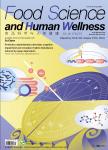Insights into the Impact of Bifidobacterium bifidum, B. breve, and B. longum on the Immune Response Against Salmonella Infection in Neonatal Rats
作者机构:State Key Laboratory of Food Science and Resources, Jiangnan University School of Food Science and Technology, Jiangnan University Microbiology Laboratory, Zhongshan Bo'ai Hospital, Southern Medical University Key Laboratory of National Health Commission on Parasitic Disease Control and Prevention, Jiangsu Provincial Key Laboratory on Parasite and Vector Control Technology, Jiangsu Institute of Parasitic Diseases National Engineering Research Center for Functional Food, Jiangnan University (Yangzhou) Institute of Food Biotechnology, Jiangnan University Wuxi Translational Medicine Research Center and Jiangsu Translational Medicine Research Institute Wuxi Branch
出 版 物:《Food Science and Human Wellness》 (食品科学与人类健康(英文))
年 卷 期:2024年
核心收录:
学科分类:08[工学] 082203[工学-发酵工程] 0822[工学-轻工技术与工程]
基 金:supported by the National Natural Science Foundation of China (No. 32272332 31972052 32021005 31820103010) the Fundamental Research Funds for the Central Universities (JUSRP622020 JUSRP22006 JUSRP51501) the Program of Collaborative Innovation Centre of Food Safety and Quality Control in Jiangsu Province Postgraduate Research&Practice Innovation Program of Jiangsu Province (KYCX22_2391)
摘 要:Infants exhibit diminished susceptibility to external infections, a phenomenon closely linked to the pervasive presence of the bifidobacterial community within their intestinal tract. Nonetheless, a significant knowledge gap remains concerning the distinct species of bifidobacteria initiating anti-infection immune responses during the early developmental stages. In this study, the impact of early intervention with Bifidobacterium bifidum (B. bifidum), B. breve, and B. longum on neonatal rats infected with Salmonella enterica serovar Typhimurium (S. typhimurium) SL1344 were compared. The study encompasses various immunity levels, including gut immunity, central immunity (thymus), peripheral immunity (spleen), and brain immunity. Following Salmonella infection, significant alterations in neonatal rats were observed in growth and developmental levels, immune markers, cytokine levels, balance of T lymphocyte subpopulations, intestinal barrier function, and blood-brain barrier integrity. Compared with B. breve and B. longum, B. bifidum demonstrated more pronounced efficacy in regulating these physiological processes. By conducting multi-level analyses of gut microbiota, bifidobacterial community, colonic content metabolomics, and serum metabolomics, the significance of B. bifidum s role is underscored, and the immune-enhancing function of messenger metabolites is unveiled. Among these metabolites, γ-L-Glutamyl-L-glutamic acid and Orotic acid were found to be shared by all three species, while Hippuric acid and 1a,1b-dihomo Prostaglandin F2α were unique to B. bifidum, and DL-Arginine was specific to B. longum. Overall, this study has provided novel insights into the intervention and immunomodulation by Bifidobacterium in early-life infections, emphasizing the significant role of B. bifidum.



